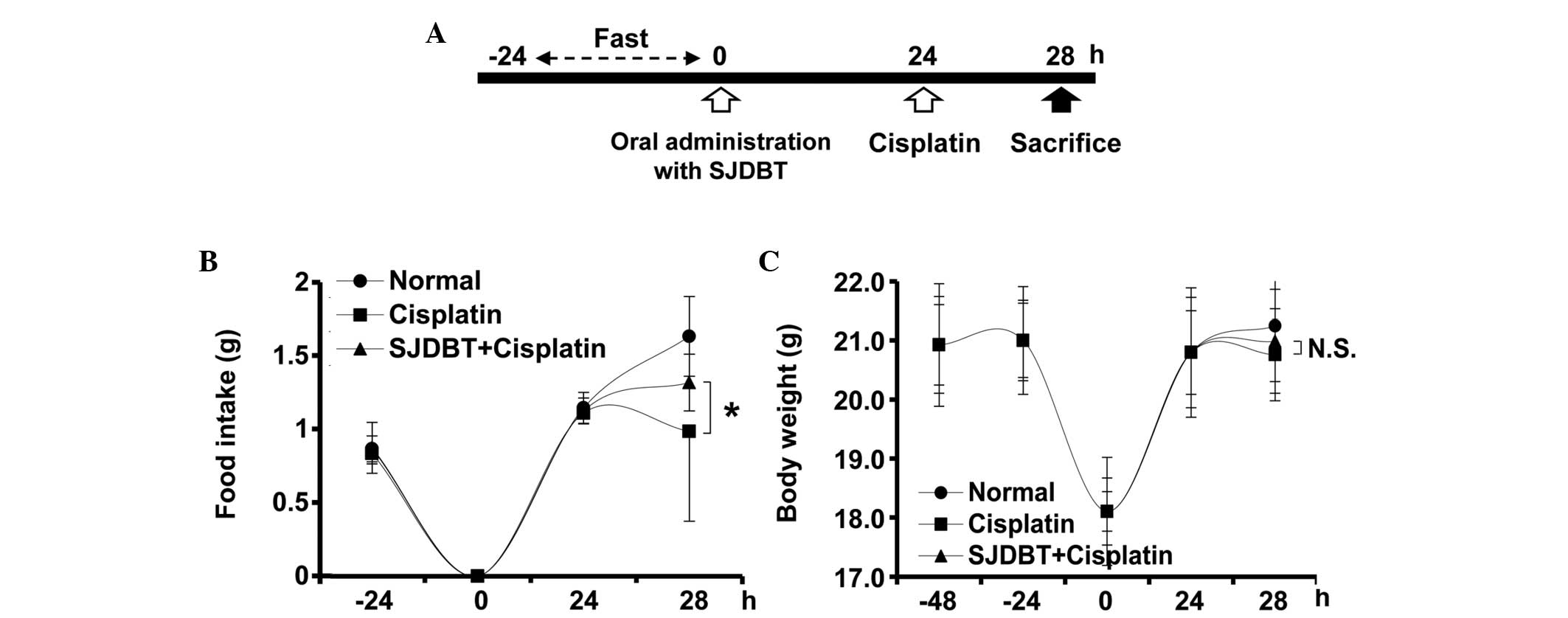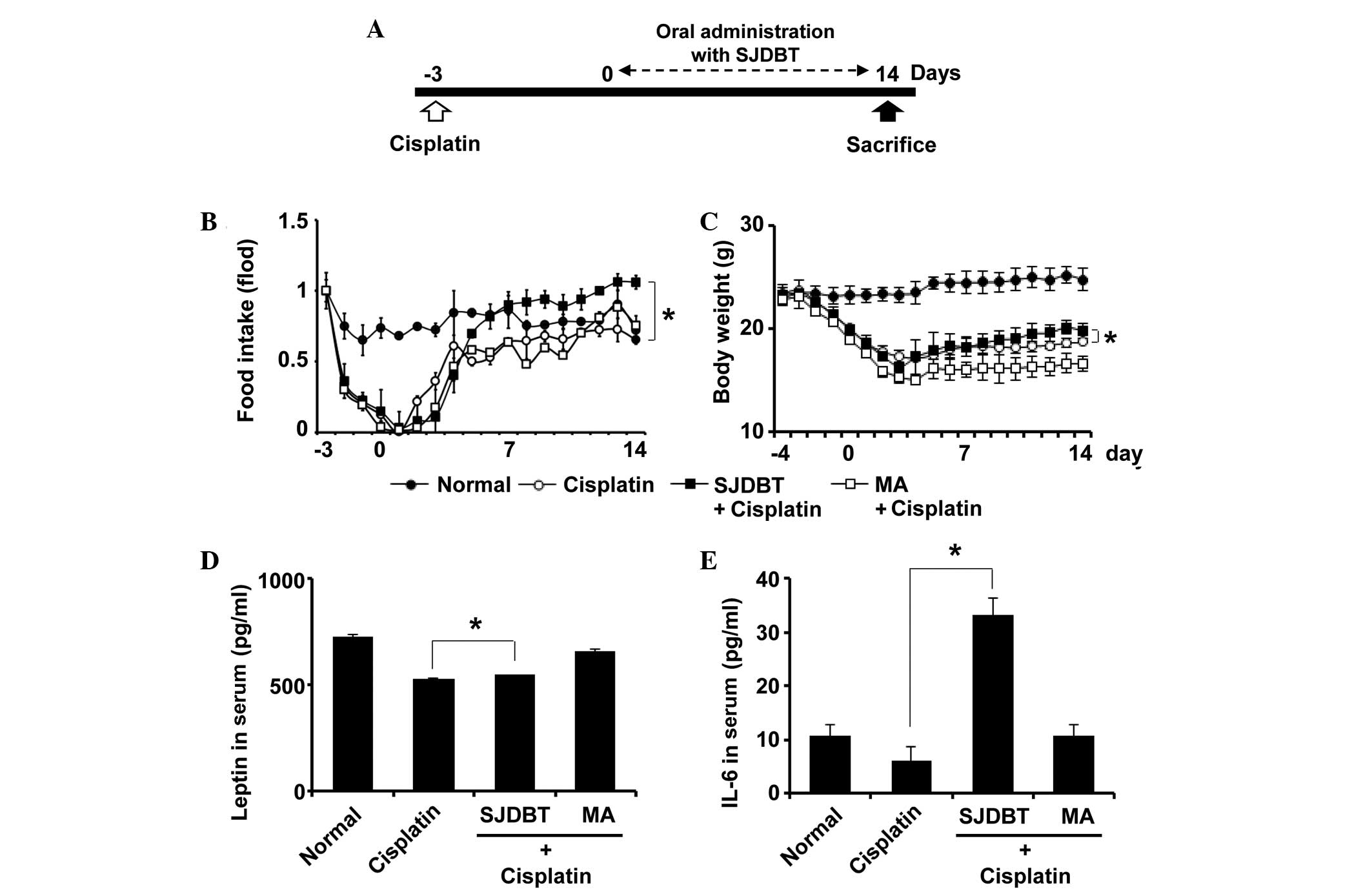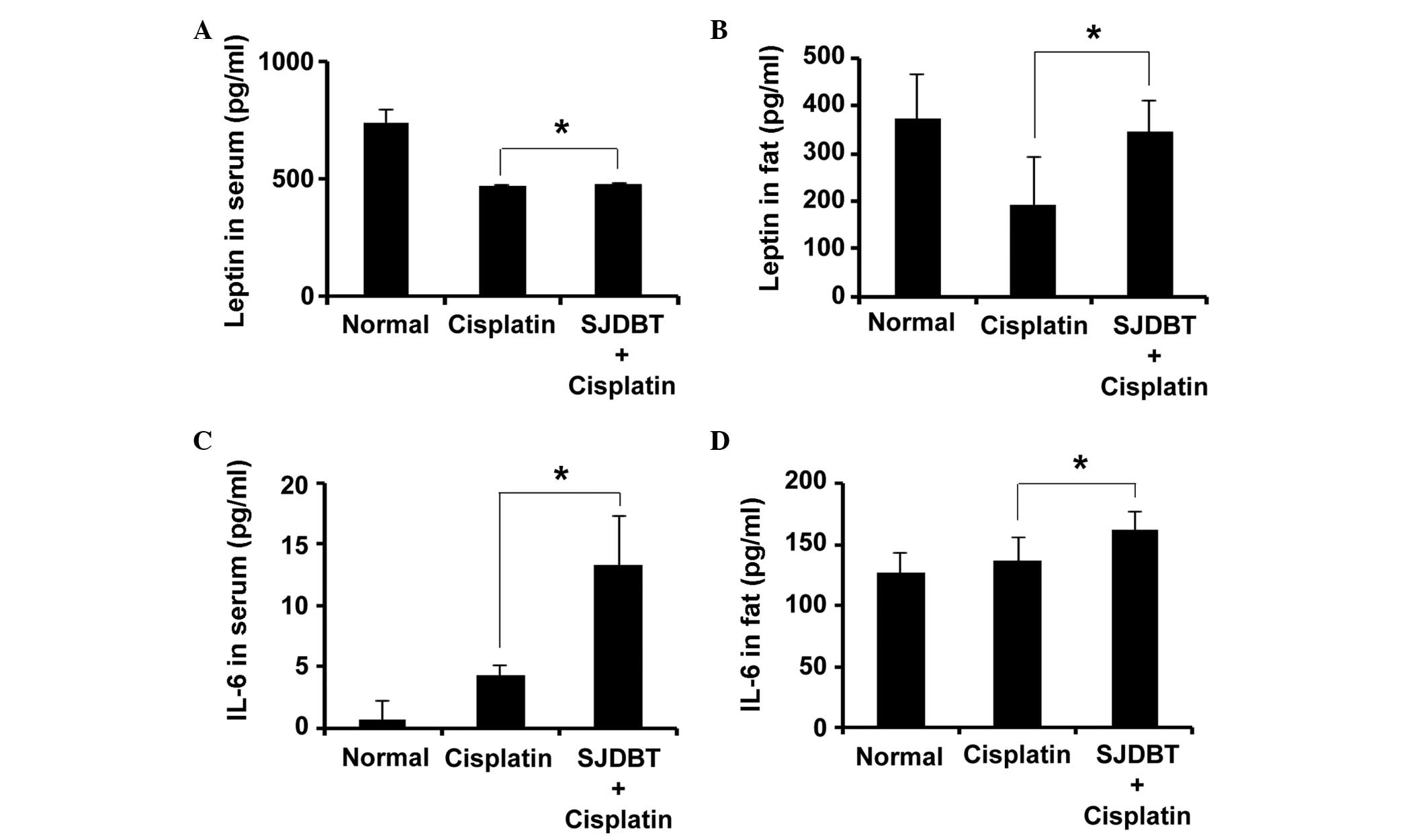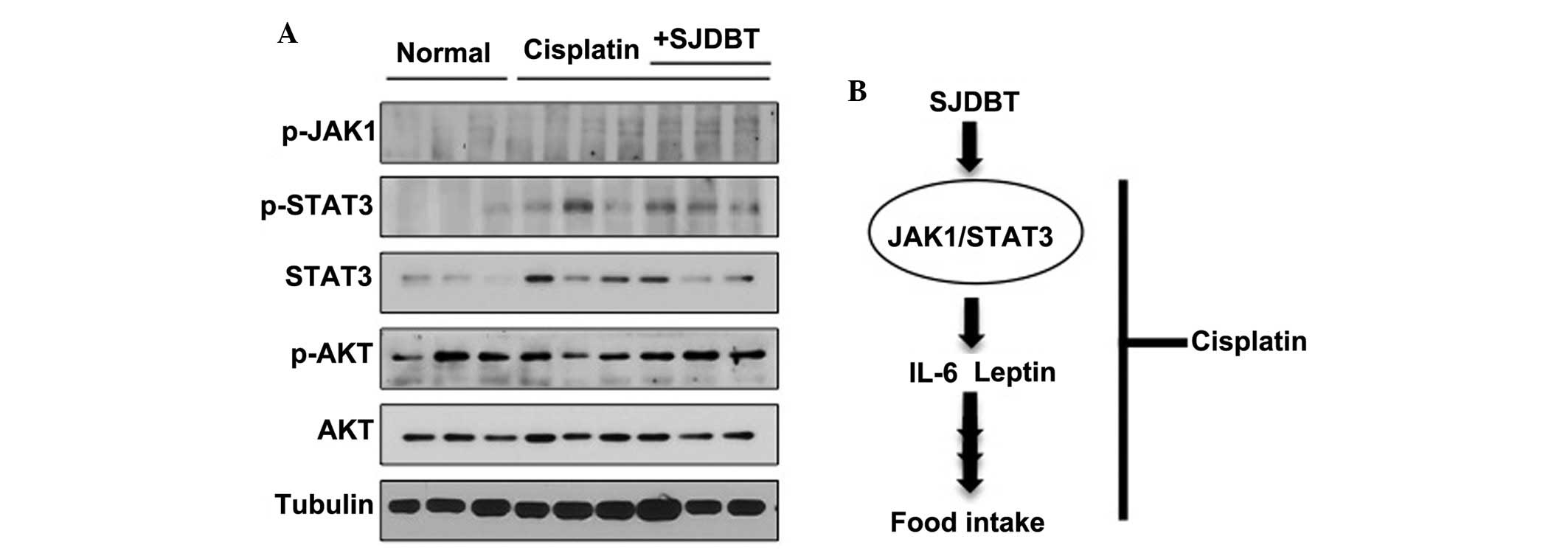Introduction
It has been reported that ~50% of patients with
cancer suffer from anorexia, one of the adverse effects caused by
chemotherapy (1–3). Cancer patients with anorexia exhibit
symptoms, including loss of appetite, weight loss, chronic fatigue,
lethargy and anemia (4,5). When these symptoms become chronic, a
loss of fat and muscle is observed, which is closely associated
with cachexia (6). Anorexia is a
major concern for patients with cancer, since it worsens the
quality of life and becomes an obstacle in cancer therapies, often
resulting in poor prognosis (7–9).
Although certain drugs have been suggested, the therapeutic options
for the treatment of anorexia remain to be determined (10,11).
Leptin, a hormone secreted predominantly by fat tissue, modulates
food intake and energy balance (12–14).
Low levels of leptin are often observed in cancer patients with
anorexia (13,15), suggesting that balanced leptin
levels may be crucial in the prevention of anorexia. Interleukin
(IL)-6 regulates leptin production and vice versa (16–19).
Furthermore, the deletion of the IL-6 receptor in mice causes a
decrease in both food intake and body weight (20). It has been revealed that the Janus
kinase (JAK)1/signal transducer and activator of transcription
(STAT)3 pathway regulates the production of leptin and IL-6 in the
fat tissue (21,22).
Sip-jeon-dea-bo-tang (SJDBT), is a traditional
herbal medicine, widely used in the treatment of various diseases,
including anorexia, anemia, extreme fatigue and weakness, in Korea,
China and Japan (23–26). SJDBT has been revealed to exhibit
anticancer effects (27–29). Previously, it was revealed that
SJDBT ameliorates cancer-induced anorexia and cachexia (30). In addition, SJDBT has been reported
to mitigate various chemotherapy-induced side effects (31–34).
Based on the aforementioned findings, SJDBT appears to have
multiple roles in the treatment of cancer; however, it remains
unclear how SJDBT ameliorates chemotherapy-induced anorexia. In the
present study, the effect of SJDBT in cisplatin-induced anorexia in
mice was investigated. SJDBT was revealed to ameliorate food intake
and body weight by altering the levels of leptin and IL-6. In the
fat tissue, SJDBT activated the JAK1/STAT3 signaling pathway,
resulting in the production of both leptin and IL-6; therefore, the
present data suggested that SJDBT may be useful in the prevention
of chemotherapy-induced anorexia.
Materials and methods
Materials
Cisplatin was purchased from Sigma-Aldrich (St.
Louis, MO, USA) and SJDBT was obtained from Hanpoong Pharm &
Foods Co., Ltd., (Jeonju, Republic of Korea). SJDBT extract was
prepared, according to the Good Manufacturing Practices guidelines
(35–37). Briefly, 10 of the components
comprising SJDBT [Angelica gigas, Astragalus
membranaceus, Atractylodes japonica, Cinnamomum
cassia, Cnidium officinale, Paeonia lactiflora, Panax
ginseng, Poria cocos and Rehmannia glutinosa (320
g each), and Glycyrrhiza uralensis (160 g)] were placed in
10-fold volume of water, boiled at 100°C for 3 h, filtered using 25
µm microfilters, and were subsequently extracted at 60°C.
Finally, 876.9 g dried extract was obtained and the average yield
was ~28.85%. Megestrol acetate (MA; Megace®) was
purchased from Santa Cruz Biotechnology, Inc. (Santa Cruz, CA,
USA). Primary polyclonal antibodies against phosphorylated
(p-)JAK1, (3331) p-STAT3 (9131), STAT3 (9132), p-AKT (9271) and AKT
(9272) were purchased from Cell Signaling Technologies (Danvers,
MA, USA). Anti-α-tubulin monoclonal antibody (T-5168) was purchased
from Sigma-Aldrich (St. Louis, MO, USA).
Animal study
A total of 42 male Balb/c mice (6-weeks-old) were
purchased from Orient Bio Inc. (Seongnam, South Korea) and were
maintained at 23±3°C (humidity, 55±15%) with a 12 h light/dark
cycle. Water was continuously provided during whole experimental
period. Following fasting for 24 h, mice were provided with food
for 28 h and food intake was observed at the indicated times
(Fig. 1A). Mice were randomly
split into three equal groups (n=6/group) as follows: Normal,
cisplatin and SJDBT + cisplatin. Water and food were provided
enough, and food was changed daily. Food intake was observed daily
at the consistent times (Fig 2A).
Mice were randomly split into three equal groups (n=6/group) as
follows: Normal, cisplatin, SJDBT + cisplatin and MA + cisplatin.
Briefly, 8 mg/kg cisplatin dissolved in water was intraperitoneally
injected into the mice, followed by daily oral administration of
678.4 mg/kg SJDBT dissolved in water and 100 mg/kg MA dissolved in
corn oil. The present animal study was approved by the Animal
Ethics Committee of Kyung Hee University [KHUASP (SE)-012-048].
Upon completion of the experiment, mice were anesthetized using
1.2% avertin solution [0.5 g 2,2,2-tribromoethanol powder dissolved
into 1 ml 2-methyl-2-butanol at 55°C and 39 ml phosphate-buffered
saline (PBS)] through a Nalgene 0.22-µ filter (Thermo Fisher
Scientific, Inc., Waltham, MA, USA) (1) and sacrificed via exsanguination.
Enzyme-linked immunosorbent assay
(ELISA)
In order to obtain the serum, blood was centrifuged
at 22.4 × g for 20 min at room temperature and the supernatant was
transferred to a new tube. Upon completion of the experiment, the
levels of IL-6 and leptin in the serum were measured using the
Millipore Mouse Metabolic Magnetic Bead Panel kit (EMD Millipore,
Billerica, MA, USA), according to the manufacturer's protocol.
Next, the levels of mouse IL-6 (BD 555240; BD Biosciences, San
Jose, CA, USA) and mouse leptin (DY498; R&D Systems, Inc.,
Minneapolis, MN, USA) were measured using ELISA kits according to
the manufacturer's protocol. All experiments were performed in
triplicate.
Western blot analysis
Primary fat tissues were isolated from the mice and
were lysed using radioimmunoprecipitation buffer (Biosesang,
Scongnam, Korea) to obtain whole protein. Protein concentration was
measured using the Bradford assay and 10 µg protein was
separated by 8% sodium dodecyl sulfate-polyacrylamide gels
electrophoresis. Separated proteins were transferred onto
polyvinylidene difluoride membranes (both GE Healthcare Life
Sciences, Freiburg, Germany) and the membranes were subsequently
blocked in 1% bovine serum albumin (BSA) and 2% skimmed milk for 1
h. Following incubation at 4°C overnight with the following primary
polyclonal antibodies against: p-JAK1, p-STAT3, STAT3, p-AKT, AKT
(all 1:1,000) and monoclonal anti-α-tubulin (1:100,000 in 3% BSA),
the membranes were incubated at room temperature for 1 h with
horseradish peroxidase-conjugated goat anti-rabbit immunglobulin G
(H+L) secondary antibody (KPL, Inc., Gaithersburg, MA, USA). The
membranes were washed three times in PBS with 0.01% Tween-20
between each step. In order to visualize the membranes, enhanced
chemiluminescence (ECL) kit solution (DoGen, Seoul, Korea) was used
and the membranes were exposed to X-ray film (AGFA Healthcare,
Mortsel, Belgium).
Statistical analysis
Statistical differences were calculated via
Student's t-test using Microsoft Excel 2007 (Microsoft Corporation,
Redmond, WA, USA). Data were presented as the mean ± standard
deviation. P<0.05 was considered to indicate a statistically
significant difference.
Results
SJDBT prevents a cisplatin-mediated
decrease in food intake
The effect of SJDBT on the food intake of mice
treated with cisplatin was investigated. The mice were initially
subjected to an oral administration of SJDBT or water, and
subsequently to an intraperitoneal injection of cisplatin (Fig. 1A). By contrast to the
cisplatin-treated mice previously described (34,38),
in which a decrease in food intake was observed, the mice treated
with SJDBT + cisplatin did not exhibit the same cisplatin-induced
decrease (Fig. 1B). In addition,
no body weight loss was observed in any of the mice in this
experiment (Fig. 1C); therefore,
the present data indicated that SJDBT prevented a cisplatin-induced
decrease in food intake in mice.
Long-term treatment of SJDBT ameliorates
cisplatin-induced anorexia
The present study next examined whether long-term
treatment with SJDBT is effective in cisplatin-induced anorexic
mice. Three days following cisplatin treatment, the mice received
oral administration of water, SJDBT or MA, every day for 14 days.
Food and water were changed daily, and the food intake and body
weight were measured daily (Fig.
2A). Food intake and body weight were markedly reduced 3 days
following cisplatin treatment (Fig. 2B
and C), confirming the success of the mouse model of
chemotherapy-induced anorexia. SJDBT was shown to markedly restore
the cisplatin-induced decrease in food intake, and recover the body
weight of the mice (Fig. 2B and
C). Subsequently, the serum levels of leptin and IL-6, which
are considered markers for anorexia, were measured. It was revealed
that cisplatin reduced the levels of serum leptin and IL-6,
consistent with previous studies (39,40),
whereas SJDBT was shown to restore them (Fig. 2D), suggesting that long-term
treatment with SJDBT may prove useful in the treatment of
cisplatin-induced anorexia.
SJDBT increases the levels of leptin and
IL-6
Since leptin and IL-6 are considered as markers for
anorexia, their serum and fat levels were measured in the mice from
the previous experiment. Cisplatin was revealed to reduce the serum
level of leptin, whereas SJDBT was shown to slightly increase the
levels of leptin (Fig. 3A).
Furthermore, SJDBT significantly rescued the cisplatin-mediated
reduction in the level of leptin in the fat (Fig. 3B). Similarly, SJDBT increased the
IL-6 levels in the serum (Fig. 3C)
and fat tissues (Fig. 3D);
therefore, the present data suggested that SJDBT may ameliorate
cisplatin-induced anorexia via the regulation of the leptin and
IL-6 levels in the fat tissue.
SJDBT increases the levels of leptin and
IL-6 via the activation the JAK/STAT3 signaling pathway in the fat
tissues of mice
The JAK1/2-STAT3 signaling pathway has been shown to
regulate both IL-6 and leptin production (16,17).
Fat tissues were isolated and were subsequently used for western
blotting. This revealed that SJDBT regulated the phosphorylation of
both JAK1 and STAT3, but not AKT (Fig.
4A). The present data therefore suggested that the
SJDBT-mediated treatment of anorexia occurs as a result of the
JAK1/STAT3-mediated production of leptin and IL-6 in the fat of
mice.
Discussion
SJDBT has been reported to ameliorate
chemotherapy-mediated side effects in mice and cancer patients
(26,31,33,41);
however, its protective role against chemotherapy-induced anorexia
remains to be elucidated. In the present study, it was found that
SJDBT prevented the cisplatin-induced decrease in food intake and
body weights in mice via the regulation of the JAK1/STAT3-mediated
production of leptin and IL-6 in the fat tissue of mice (21,22).
Our previous study revealed that SJDBT regulated
various cytokines and hormones involved in appetite, including
IL-6, monocyte chemoattractant protein-1, peptide YY and
glucagon-like peptide-1, and ameliorated cancer-induced anemia
(30). In addition, SJDBT has been
shown to protect immune defects in patients with cancer undergoing
chemotherapy (31–33,41).
The regulation of cytokine production by SJDBT appears to have
unique therapeutic effects; however, its role against anorexia
remains to be elucidated. In the present study, it was found that
SJDBT restored decreased food intake levels and the decreased body
weight induced by cisplatin. Furthermore, SJDBT regulated the
production of IL-6 and leptin.
In our previous study, SJDBT failed to regulate the
level of leptin in tumor-bearing mice (30), which suggests that the regulation
of leptin by SJDBT appears to be limited to cisplatin-induced
anorexia. In addition, the data from multiplex assays revealed that
SJDBT did not markedly alter various cytokines and hormones,
including ghrelin, in both cisplatin-induced and cancer-associated
anorexia mouse models (data not shown). Therefore, SJDBT regulation
of IL-6 production seems to be unique in experimental systems
reflecting either chemotherapy-induced or cancer-associated
anorexia. IL-6 is known to regulate anorexia and cachexia, which is
crucial for the improvement of the survival rates of patients with
cancer (42). IL-6 is also known
to activates the JAK/STAT signaling pathway, resulting in an
increase in IL-6 production (43,44).
In the present study, SJDBT activated JAK1 and STAT3, but not AKT,
suggesting that SJDBT regulates food intake by activating
JAK1/STAT3-mediated IL-6 production.
It remains unknown which compounds in SJDBT are
effective and what their effects are in cells, tissues and organs,
which comprises a major challenge for studies on herbal medicines.
With regard to SJDBT, high performance liquid chromatography
fingerprint analysis was performed (45), thereby providing hints for
effective components.
Numerous patients from countries in East Asia
receive SJDBT for the treatment of certain diseases, including
various cancers, anorexia, cachexia, chronic fatigue, immunization
disease, female disorder and blood-flow disorders, despite the lack
of scientific evidence regarding the role of SJDBT in these
diseases. The aim of the present study was therefore to obtain a
deeper understanding of the role of SJDBT against cisplatin-induced
anorexia in mice. The collected data suggested that SJDBT may be
useful in the treatment of anorexia in patients with cancer
undergoing chemotherapy.
It was demonstrated that SJDBT prevents
cisplatin-induced anorexia in mice by regulating the
JAK1/STAT3-mediated production of IL-6 and leptin, therefore
suggesting that SJDBT ameliorates chemotherapy-induced
anorexia.
Acknowledgments
The present study was supported by a grant from the
Korean Medicine R&D project of the Ministry of Health and
Welfare (no. B120014) and by the National Research Foundation of
Korea, which is funded by the Ministry of Science (grant no.
2007-0054931).
References
|
1
|
Inui A: Cancer anorexia-cachexia syndrome:
Current issues in research and management. CA Cancer J Clin.
52:72–91. 2002. View Article : Google Scholar : PubMed/NCBI
|
|
2
|
Sinno MH, Coquerel Q, Boukhettala N,
Coëffier M, Gallas S, Terashi M, Ibrahim A, Breuillé D, Déchelotte
P and Fetissov SO: Chemotherapy-induced anorexia is accompanied by
activation of brain pathways signaling dehydration. Physiol Behav.
101:639–648. 2010. View Article : Google Scholar : PubMed/NCBI
|
|
3
|
Jahn P, Renz P, Stukenkemper J, Book K,
Kuss O, Jordan K, Horn I, Thoke-Colberg A, Schmoll HJ and
Landenberger M: Reduction of chemotherapy-induced anorexia, nausea
and emesis through a structured nursing intervention: A
cluster-randomized multicenter trial. Support Care Cancer.
17:1543–1552. 2009. View Article : Google Scholar : PubMed/NCBI
|
|
4
|
Abell TL, Malagelada JR, Lucas AR, Brown
ML, Camilleri M, Go VL, Azpiroz F, Callaway CW, Kao PC, Zinsmeister
AR, et al: Gastric electromechanical and neurohormonal function in
anorexia nervosa. Gastroenterology. 93:958–965. 1987.PubMed/NCBI
|
|
5
|
Bernstein IL and Bernstein ID: Learned
food aversions and cancer anorexia. Cancer Treat Rep. 65(Suppl 5):
S43–S47. 1981.
|
|
6
|
Mantovani G, Macció A, Massa E and Madeddu
C: Managing cancer-related anorexia/cachexia. Drugs. 61:499–514.
2001. View Article : Google Scholar : PubMed/NCBI
|
|
7
|
Langhans W: Anorexia of infection: Current
prospects. Nutrition. 16:996–1005. 2000. View Article : Google Scholar : PubMed/NCBI
|
|
8
|
Exton MS: Infection-induced anorexia:
Active host defence strategy. Appetite. 29:369–383. 1997.
View Article : Google Scholar
|
|
9
|
Tohgo A, Kumazawa E, Akahane K, Asakawa A
and Inui A: Anticancer drugs that induce cancer-associated
cachectic syndromes. Expert Rev Anticancer Ther. 2:121–129. 2002.
View Article : Google Scholar : PubMed/NCBI
|
|
10
|
Suárez-Pinilla P, Peña-Pérez C,
Arbaizar-Barrenechea B, Crespo-Facorro B, Del Barrio JA, Treasure J
and Llorca-Díaz J: Inpatient treatment for anorexia nervosa: A
systematic review of randomized controlled trials. J Psychiatr
Pract. 21:49–59. 2015. View Article : Google Scholar : PubMed/NCBI
|
|
11
|
Mondello P, Mian M, Aloisi C, Famá F,
Mondello S and Pitini V: Cancer cachexia syndrome: Pathogenesis,
diagnosis and new therapeutic options. Nutr Cancer. 67:12–26. 2015.
View Article : Google Scholar
|
|
12
|
Brennan AM and Mantzoros CS: Drug Insight:
The role of leptin in human physiology and pathophysiology-emerging
clinical applications. Nat Clin Pract Endocrinol Metab. 2:318–327.
2006. View Article : Google Scholar : PubMed/NCBI
|
|
13
|
Hebebrand J, Muller TD, Holtkamp K and
Herpertz-Dahlmann B: The role of leptin in anorexia nervosa:
Clinical implications. Mol Psychiatry. 12:23–35. 2007. View Article : Google Scholar
|
|
14
|
Eckert ED, Pomeroy C, Raymond N, Kohler
PF, Thuras P and Bowers CY: Leptin in anorexia nervosa. J Clin
Endocrinol Metab. 83:791–795. 1998.PubMed/NCBI
|
|
15
|
Smiechowska J, Utech A, Taffet G, Hayes T,
Marcelli M and Garcia JM: Adipokines in patients with cancer
anorexia and cachexia. J Investig Med. 58:554–559. 2010.PubMed/NCBI
|
|
16
|
Tang CH, Lu DY, Yang RS, Tsai HY, Kao MC,
Fu WM and Chen YF: Leptin-induced IL-6 production is mediated by
leptin receptor, insulin receptor substrate-1, phosphatidylinositol
3-kinase, Akt, NF-kappaB and p300 pathway in microglia. J Immunol.
179:1292–1302. 2007. View Article : Google Scholar : PubMed/NCBI
|
|
17
|
Trujillo ME, Sullivan S, Harten I,
Schneider SH, Greenberg AS and Fried SK: Interleukin-6 regulates
human adipose tissue lipid metabolism and leptin production in
vitro. J Clin Endocrinol Metab. 89:5577–5582. 2004. View Article : Google Scholar : PubMed/NCBI
|
|
18
|
Engineer DR and Garcia JM: Leptin in
anorexia and cachexia syndrome. Int J Pept. 2012:2874572012.
View Article : Google Scholar : PubMed/NCBI
|
|
19
|
Faggioni R, Feingold KR and Grunfeld C:
Leptin regulation of the immune response and the immunodeficiency
of malnutrition. FASEB J. 15:2565–2571. 2001. View Article : Google Scholar : PubMed/NCBI
|
|
20
|
Shirazi R, Palsdottir V, Collander J,
Anesten F, Vogel H, Langlet F, Jaschke A, Schürmann A, Prévot V,
Shao R, et al: Glucagon-like peptide 1 receptor induced suppression
of food intake and body weight is mediated by central IL-1 and
IL-6. Proc Natl Acad Sci USA. 110:16199–16204. 2013. View Article : Google Scholar
|
|
21
|
Hübschle T, Thom E, Watson A, Roth J,
Klaus S and Meyerhof W: Leptin-induced nuclear translocation of
STAT3 immuno-reactivity in hypothalamic nuclei involved in body
weight regulation. J Neurosci. 21:2413–2424. 2001.
|
|
22
|
Priceman SJ, Kujawski M, Shen S,
Cherryholmes GA, Lee H, Zhang C, Kruper L, Mortimer J, Jove R,
Riggs AD and Yu H: Regulation of adipose tissue T cell subsets by
Stat3 is crucial for diet-induced obesity and insulin resistance.
Proc Natl Acad Sci USA. 110:13079–13084. 2013. View Article : Google Scholar : PubMed/NCBI
|
|
23
|
Borman NH: The history of ancient Korean
medicine. Yonsei Med J. 7:103–118. 1966. View Article : Google Scholar : PubMed/NCBI
|
|
24
|
Zee-Cheng RK: Shi-quan-da-bu-tang (ten
significant tonic decoction), SQT. A potent Chinese biological
response modifier in cancer immunotherapy, potentiation and
detoxification of anticancer drugs. Methods Find Exp Clin
Pharmacol. 14:725–736. 1992.PubMed/NCBI
|
|
25
|
Saiki I: A Kampo medicine 'Juzen-taiho-to'
prevention of malignant progression and metastasis of tumor cells
and the mechanism of action. Biol Pharm Bull. 23:677–688. 2000.
View Article : Google Scholar : PubMed/NCBI
|
|
26
|
Kishida Y, Nishii T, Inoue T, Nishida S,
Arimitsu J, Yoshikawa H and Sugano N: Juzentaihoto (TJ-48), a
traditional Japanese herbal medicine, influences hemoglobin
recovery during preoperative autologous blood donation and after
hip surgery. Int J Clin Pharmacol Ther. 47:716–721. 2009.
View Article : Google Scholar : PubMed/NCBI
|
|
27
|
Wang CY, Bai XY and Wang CH: Traditional
Chinese medicine: A treasured natural resource of anticancer drug
research and development. Am J Chin Med. 42:543–559. 2014.
View Article : Google Scholar : PubMed/NCBI
|
|
28
|
Kin R, Kato S, Kaneto N, Sakurai H,
Hayakawa Y, Li F, Tanaka K, Saiki I and Yokoyama S: Procyanidin C1
from cinnamomi cortex inhibits TGF-β-induced
epithelial-to-mesenchymal transition in the A549 lung cancer cell
line. Int J Oncol. 43:1901–1906. 2013.PubMed/NCBI
|
|
29
|
Matsuda T, Maekawa K, Asano K and
Hisamitsu T: Suppressive effect of juzen-taiho-to on lung
metastasis of b16 melanoma cells in vivo. Evid Based Complement
Alternat Med. 2011:7431532011. View Article : Google Scholar :
|
|
30
|
Choi YK, Jung KY, Woo SM, Yun YJ, Jun CY,
Park JH, Shin YC, Cho SG and Ko SG: Effect of Sipjeondaebo-tang on
cancer-induced anorexia and cachexia in CT-26 tumor-bearing mice.
Mediators Inflamm. 2014:7365632014. View Article : Google Scholar : PubMed/NCBI
|
|
31
|
Huang SM, Chien LY and Tai CJ, Chiou JF,
Chen CS and Tai CJ: Effectiveness of 3-week intervention of Shi
Quan Da Bu Tang for alleviating hematotoxicity among patients with
breast carcinoma receiving chemotherapy. Integr Cancer Ther.
12:136–144. 2013. View Article : Google Scholar
|
|
32
|
Ogawa K, Omatsu T, Matsumoto C, Tsuchiya
N, Yamamoto M, Naito Y and Yoshikawa T: Protective effect of the
Japanese traditional medicine juzentaihoto on myelosuppression
induced by the anticancer drug TS-1 and identification of a
potential biomarker of this effect. BMC Complement Altern Med.
12:1182012. View Article : Google Scholar : PubMed/NCBI
|
|
33
|
Sugiyama K, Ueda H and Ichio Y: Protective
effect of juzen-taiho-to against carboplatin-induced toxic side
effects in mice. Biol Pharm Bull. 18:544–548. 1995. View Article : Google Scholar : PubMed/NCBI
|
|
34
|
Talley RW, O'Bryan RM, Gutterman JU,
Brownlee RW and McCredie KB: Clinical evaluation of toxic effects
of cis-diamminedichloroplatinum (NSC-119875)-phase I clinical
study. Cancer Chemother Rep. 57:465–471. 1973.PubMed/NCBI
|
|
35
|
Safety MOFAD: Guidance on good
manufacturing practices (GMP) for active pharmaceutical
ingredients. 2nd Edition. Korea: 2015
|
|
36
|
World Health Organization: Annex 3
supplementary guidelines on good manufacturing practices for the
manufacture of herbal medicines. (WHO Technical Report Series). pp.
85–106. 2006
|
|
37
|
Center for Drug Evaluation and Research
PQMSC: Pharmaceutical components at risk for melamine contamination
services. Dohah US: 1992
|
|
38
|
Higby DJ, Wallace HJ Jr and Holland JF:
Cis-diamminedichloroplatinum (NSC-119875): A phase I study. Cancer
Chemother Rep. 57:459–463. 1973.PubMed/NCBI
|
|
39
|
Poth KJ, Guminski AD, Thomas GP, Leo PJ,
Jabbar IA and Saunders NA: Cisplatin treatment induces a transient
increase in tumorigenic potential associated with high
interleukin-6 expression in head and neck squamous cell carcinoma.
Mol Cancer Ther. 9:2430–2439. 2010. View Article : Google Scholar : PubMed/NCBI
|
|
40
|
Fantuzzi G and Faggioni R: Leptin in the
regulation of immunity, inflammation and hematopoiesis. J Leukoc
Biol. 68:437–446. 2000.PubMed/NCBI
|
|
41
|
Sugiyama K, Ueda H, Ichio Y and Yokota M:
Improvement of cisplatin toxicity and lethality by juzen-taiho-to
in mice. Biol Pharm Bull. 18:53–58. 1995. View Article : Google Scholar : PubMed/NCBI
|
|
42
|
Suh SY, Choi YS, Yeom CH, Kwak SM, Yoon
HM, Kim DG, Koh SJ, Park J, Lee MA, Lee YJ, et al: Interleukin-6
but not tumour necrosis factor-alpha predicts survival in patients
with advanced cancer. Supportive Care Cancer. 21:3071–3077. 2013.
View Article : Google Scholar
|
|
43
|
Wang SW and Sun YM: The IL-6/JAK/STAT3
pathway: Potential therapeutic strategies in treating colorectal
cancer (Review). Int J Oncol. 44:1032–1040. 2014.PubMed/NCBI
|
|
44
|
Huang WL, Yeh HH, Lin CC, Lai WW, Chang
JY, Chang WT and Su WC: Signal transducer and activator of
transcription 3 activation up-regulates interleukin-6 autocrine
production: A biochemical and genetic study of established cancer
cell lines and clinical isolated human cancer cells. Mol Cancer.
9:3092010. View Article : Google Scholar : PubMed/NCBI
|
|
45
|
Saiki I, Yamaura T, Ohnishi Y, Hayakawa Y,
Komatsu Y and Nunome S: HPLC analysis of juzen-taiho-to and its
variant formulations and their antimetastatic efficacies. Chem
Pharm Bull (Tokyo). 47:1170–1174. 1999. View Article : Google Scholar
|


















